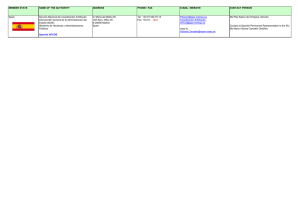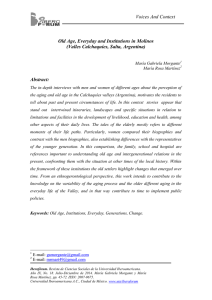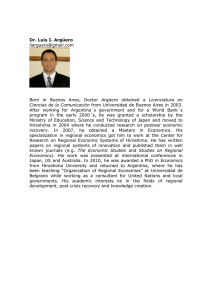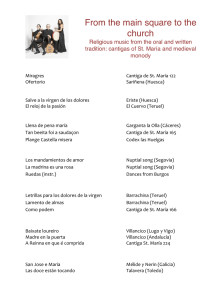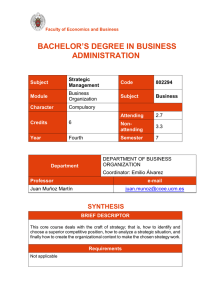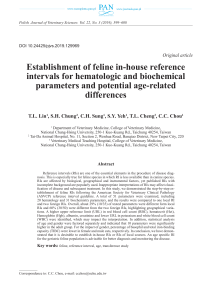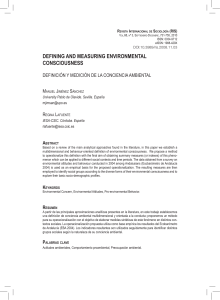Time discounting and pain anticipation. Experimental evid
Anuncio
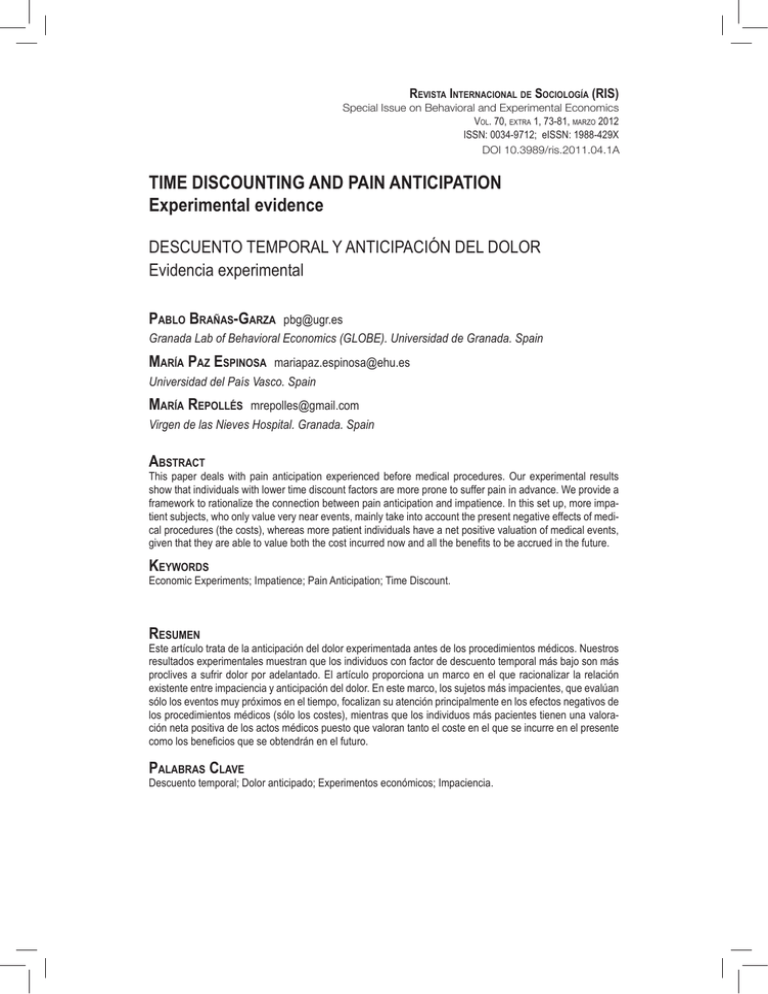
Revista Internacional de Sociología (RIS) Special Issue on Behavioral and Experimental Economics Vol. 70, extra 1, 73-81, marzo 2012 ISSN: 0034-9712; eISSN: 1988-429X DOI 10.3989/ris.2011.04.1A Time discounting and pain anticipation Experimental evidence Descuento temporal y anticipación del dolor Evidencia experimental Pablo Brañas-Garza [email protected] Granada Lab of Behavioral Economics (GLOBE). Universidad de Granada. Spain María Paz Espinosa [email protected] Universidad del País Vasco. Spain María Repollés [email protected] Virgen de las Nieves Hospital. Granada. Spain Abstract This paper deals with pain anticipation experienced before medical procedures. Our experimental results show that individuals with lower time discount factors are more prone to suffer pain in advance. We provide a framework to rationalize the connection between pain anticipation and impatience. In this set up, more impatient subjects, who only value very near events, mainly take into account the present negative effects of medical procedures (the costs), whereas more patient individuals have a net positive valuation of medical events, given that they are able to value both the cost incurred now and all the benefits to be accrued in the future. Keywords Economic Experiments; Impatience; Pain Anticipation; Time Discount. Resumen Este artículo trata de la anticipación del dolor experimentada antes de los procedimientos médicos. Nuestros resultados experimentales muestran que los individuos con factor de descuento temporal más bajo son más proclives a sufrir dolor por adelantado. El artículo proporciona un marco en el que racionalizar la relación existente entre impaciencia y anticipación del dolor. En este marco, los sujetos más impacientes, que evalúan sólo los eventos muy próximos en el tiempo, focalizan su atención principalmente en los efectos negativos de los procedimientos médicos (sólo los costes), mientras que los individuos más pacientes tienen una valoración neta positiva de los actos médicos puesto que valoran tanto el coste en el que se incurre en el presente como los beneficios que se obtendrán en el futuro. Palabras Clave Descuento temporal; Dolor anticipado; Experimentos económicos; Impaciencia. 74 • PABLO BRAÑASGARZA, MARÍA PAZ ESPINOSA and MARÍA REPOLLÉS Motivation This paper provides an example of how experimental economics (time discounting behavior) might shed some light on the analysis of a medical problem; specifically, pain anticipation experienced before medical procedures. Time preferences reflect subjects’ tastes toward the present versus the future and determine intertemporal choices which involve a tradeoff between costs and benefits that occur over time (Laibson, 1997). We use an experimental time discounting test to check whether personal attitudes towards the future are correlated with pain anticipation. Recent studies suggest that there are psychological and neuronal mechanisms which determine intertemporal choice (Wittman and Paulus, 2009). Time preferences are related to impulsive or impatient behavior and it is argued that people who maintain unhealthy lifestyles (that is, smoke, eat junk food, are sport-averse, etc.) seldom place a high premium on the future quality of their lives and typify an impatient personality. In other words, they prefer good lives now to a higher quality of their lives later (Budría, Lacomba, Lagos and Swedberg, 2012; Cutler and Glaeser, 2005). Recent medical research on nocebo response —the subject’s negative expectation of pain worsening— shows the crucial role of anxiety on pain perception (and reporting). It has been found that anxiety triggers the activation of cholecystokinin that, in turn, facilitates pain transmission (Colloca and Benedetti, 2007). Additionally, nocebo response is associated to the functioning and efficiency of the reward system (Enck, Benedetti and Schedlowski, 2008). These negative expectations increase patients’ level of anxiety and consequently trigger an activation which generates pain transmission. Our experimental results show that present-oriented individuals (impatient people) are more prone to suffer pain in advance. This suggests that time preferences may be a complementary explanation to anxiety before medical procedures (Colloca and Benedetti, 2007). We provide a framework to rationalize the connection between pain anticipation and impatience. In this set up, more impatient subjects, who only value very near events, mainly take into account the negative effects of medical interventions (only costs), whereas more patient individuals have a net positive valuation of medical events (given that they consider both the cost incurred now and all the benefits to be accrued in the future). Our results are consistent with the idea of a subjective perception of time as the basis for temporal discounting (Brañas-Garza, Espinosa and Repollés, 2010; Wittmann and Paulus, 2008). Financial support from the Spanish Ministry of Science and Innovation (SEJ2007-62081 and ECO200909120 and ECO2010-17049), the Government of Andalusia Project for Excellence in Research (P07. SEJ.02547), Gobierno Vasco-DEUI (IT-313-07) and the Women’s Institute of Spain (2008.031) is also gratefully acknowledged. * RIS, vol. 70. extra 1, 73-81, MARZO 2012. ISSN: 0034-9712 doi 10.3989/ris.2011.04.15 TIME DISCOUNTING AND PAIN ANTICIPATION • 75 Theoretical Background In this section we present the theoretical relationship between time discounting and pain anticipation. To do so, let us consider the case of an individual that at moment t (today) values the potential benefits of undergoing a medical procedure (surgery, dentistry, etc.) tomorrow, that is, t+1. This subject will compute today both the cost of the medical procedure (in terms of reduced well-being due to pain) and the future benefits of well-being at t+2, t+3, ..., T (Golub, Gilbert and Wilson, 2009). Figure 1 illustrates this idea. Figure 1. Temporal prospect t t+1 t+2 t+3 t+4 Costs …. T Benefits In our approach, the key issue is how subjects value this temporal prospect of length T-t. We use Laibson’s (1997) approximation where the utility of each subject, at moment t, depends on the well-being (utility of consumption) of tomorrow t+1 and subsequent periods t+ τ ( τ = 1...T-t ) discounted by δτ, and where parameter β ∈ [0,1] captures the preference for immediate rewards: T −t ⎡ ⎤ (1) U t = E t ⎢ u(c t ) + β δ τ u (c t +τ ) ⎥ ⎦ ⎣ τ =1 ∑ € T −t ⎡ ⎤ E t ⎢ u(c t ) + βδ u(c t +1 ) + β∑δ τ u (c t +τ ) ⎥ = ⎣ ⎦ τ =2 (2) Equation (1) is the original expression, while equation (2) separates the day of the intervention (t+1) from the rest of the days (t+2, t+3, ..., T) to account for the fact that costs are incurred in t+1 and benefits accrue in t+2, t+3, ..., T. Note that neither costs nor bene€ so both are affected by β. Hence, an individual concerned only with fits are immediate RIS, vol. 70. extra 1, 73-81, MARZO 2012. ISSN: 0034-9712 doi 10.3989/ris.2011.04.15 76 • PABLO BRAÑASGARZA, MARÍA PAZ ESPINOSA and MARÍA REPOLLÉS immediate rewards (β=0) would not anticipate pain in t. Pain anticipation in t is related to discount (δ). Figure 2 illustrates the effect of discounting (δ) on the valuation of future prospects. In Figure 2 we compare the valuation of future events βδτ for different values of δ ranging from hardly impatient subjects (δ=0.1) to highly patient individuals (δ=0.999), for β=1. It is easy to check that patient subjects value even very distant outcomes, whereas impatient individuals give a very low (or no) value to relatively close events. Figure 2. Temporal valuation In other words, a myopic subject (δ=0.1) will value “only” the cost of the surgery at t+1 (and will assign very little weight to any future benefits at periods t+τ), whereas a futureoriented individual will value both the cost at t+1 and all the subsequent benefits at t+τ. In sum, a future-minded individual could value a medical intervention positively (given that it is already prescribed by a physician), whereas a present-oriented subject might compute only the pain. Experimental Design and Sample Our first core variable–discounting–is usually obtained through a simple experimental mechanism (Viscusi, Huber and Bell, 2008): the individual is asked to choose between a given amount of money at moment t, mt , versus a larger amount, MT=mt+b, at moment T (T > t; b ≥0). The tradeoff for the subject is that he can get more money in exchange for a longer wait. Obviously, the decision regarding waiting (T−t) periods depends on the discount RIS, vol. 70. extra 1, 73-81, MARZO 2012. ISSN: 0034-9712 doi 10.3989/ris.2011.04.15 TIME DISCOUNTING AND PAIN ANTICIPATION • 77 factor δ and on the value of b. When b →∞, only irrational people will not wait. On the other hand, for b →0, nobody will wait. To elicit subjects’ time preferences in our study, we asked subjects which value of b would make them indifferent between receiving an amount of money M in one month’s time and the amount M-b tomorrow. Subjects performed this task as follows: We offer you 100 Euros that you will receive after 30 days. How much money are you willing to pay in order to get that money tomorrow? That is, how much of the 100 Euros would you sacrifice to receive the money in advance? From the 100 Euros I would pay _____ euros. To create the proper incentives, one subject (out of 40) was randomly selected in each of the three sessions to be paid with real money.1 Our second core variable–pain anticipation to medical events–is obtained using a self-reported questionnaire. We asked subjects: When you know you are going to suffer a painful experience, do you start feeling pain even before the experience actually takes place? Observe that this question does not mention any specific pain. Instead, the individual is asked about his life experience in general, that is, we are not framing to any particular event. The question does not refer to general anxiety or fear of pain, but to anticipation of an event that will surely be painful (“when you know you’re going to...”). Hence, this measure should provide us a lower-bound: subjects who answer affirmatively are, in fact, pain anticipators. Brañas-Garza et al. (2010) show that this binary variable correlates significantly with pain sensitivity (the period of time that elapses before a person experiences pain after an injury), but is uncorrelated to pain endurance (the period of time that elapses before a person experiencing pain will seek relief from their symptoms). The experiment was conducted in three sessions at the University of Granada (Spain) in September and December 2009. Subjects were invited to participate through posters placed at the School. Participation was voluntary. All the sessions were run by the first co-author. Questionnaire data were collected from 130 university students (55% women, average age=24.4 years), who voluntarily participated in the experiment. Experimental economists use real payoffs (money) to incentivize subjects. In contrast to Psychology where payoffs are hypothetical we use real earnings. There earnings are conditional to subjects’ choices along the experimental session. See García-Gallego et al. (2012) as example of risky-decision making with real losses or Brandts and Fatas (2012) for social dilemmas involving monetary consequences. 1 RIS, vol. 70. extra 1, 73-81, MARZO 2012. ISSN: 0034-9712 doi 10.3989/ris.2011.04.15 78 • PABLO BRAÑASGARZA, MARÍA PAZ ESPINOSA and MARÍA REPOLLÉS The subjects were economics and business students (graduate students and undergraduates in the last two years of their degree). The average health status is high (mean=2.81) as measured on a scale from very bad (0) to excellent (4). No subjects reported the minimum level of health (very bad). Finally, to explore the correlation, if any, between the variables described before we use non-parametric tests. Specifically we use the Kolmogorov-Smirnov test for unpaired samples. Results Before showing the results, we should mention that 21 subjects (out of 130, 16%) were unable to perform the discounting task properly. Other similar procedures like Payment cards produce a similar rate of inconsistencies (around 20%). They wrote sentences like “I prefer money for sure (in advance) rather than future money” (instead of fixing an amount), “nothing” or simply left the space blank. Of the total number of subjects, 101 completed both the pain anticipation and the time preference questions. In the first question, 44% of the subjects reported pain anticipation. The amount of money they were willing to sacrifice in order to speed up the time before receiving it varies substantially across subjects (mean=14.65; st.dev =17.91; min=0; max=80). Figure 3 shows the histograms of the willingness to pay for two groups of subjects: those who did not anticipate pain (=0) and those who did (=1). Figure 3. Histograms of impatience by pain anticipation 0,4 0,35 0,3 0,25 an3cipa3on=0 an3cipa3on=1 0,2 0,15 0,1 0,05 0 euros 2 4 6 8 10 12 14 16 18 20 22 24 26 28 30 32 34 36 38 40 42 44 46 48 50+ euros 0 RIS, vol. 70. extra 1, 73-81, MARZO 2012. ISSN: 0034-9712 doi 10.3989/ris.2011.04.15 TIME DISCOUNTING AND PAIN ANTICIPATION • 79 We observe that the group of subjects who did not anticipate pain (dark grey bar) showed lower values (higher δ’s) than their colleagues who did anticipate pain (light grey bar). In fact, the number of subjects who were willing to pay 0 in order to get the payment in advance is much higher among those who did not anticipate pain (37%) than among those who did (8%). These results illustrate how pain anticipation and impatience are positively correlated. The Kolmogorov-Smirnov test reports the same result (Z=0.41; p-value=0.00). In sum, subjects belonging to both categories do not behave similarly, that is, they are not drawn from the same population. Therefore, we can conclude that present-oriented individuals are more prone to suffer pain in advance. Discussion This paper shows that anticipatory pain is related to time discounting. In the medical literature pain anticipation is attributed to anxiety (Colloca and Benedetti, 2007). We rationalize pain anticipation considering that subjects value not only their present well-being but also their future health status. Since subjects differ in their time preferences, we find that some individuals mainly weight the prospect of pain associated to a medical procedure and heavily discount the future benefits, while others have a higher discount factor (δ) and weight the future benefits highly. In this framework, anxiety could be the consequence of time preferences which assign a high value to a painful event which is close in time. An interesting avenue for further research is suggested by recent work in Neuroeconomics (Fehr, 2002; McClure, Laibson, Loewestein and Cohen, 2004, 2007). When an intertemporal choice includes an immediate reward, limbic reward-related areas show greater activity than when the alternatives include only delayed rewards. In contrast, the lateral prefrontal and parietal cortex (areas commonly associated with deliberative cognitive processes, including future planning) do not exhibit sensitivity to immediacy although they react to intertemporal choices in general. People with greater activation in the limbic rewards region are more present oriented (Hariri, Brown, Williamson, Flory, de Wit and Manuk, 2006). This literature has also dealt with negative rewards (Knutson and Peterson, 2005), which are relevant to our research on pain anticipation. It has been suggested that the expectation of losses does not activate the same areas of the brain2 as the expectation of gains. Kuhnen and Knutson (2005) showed that the prospect of a $5 gain activated the nucleus accumbens, while the anticipation of a $5 loss did not. The possibility of a 2 Coricelli and Nagel (2012) provides an example of how brain activity correlates to economic behavior. RIS, vol. 70. extra 1, 73-81, MARZO 2012. ISSN: 0034-9712 doi 10.3989/ris.2011.04.15 80 • PABLO BRAÑASARZA, MARÍA PAZ ESPINOSA and MARÍA REPOLLÉS negative reward generates greater overall brain activity and slower response times than in the case of a positive reward (Camerer, 2003; Smith, Dickhaut, McCabe and Pardo, 2002). Intertemporal decisions are important in economics as individuals show heterogeneity on how they take decisions in this respect. This heterogeneity, which could be due to a different functioning of the relevant areas in the brain, is formalized through differences in the discount factor. Our experimental results suggest a relationship between suffering and anxiety prior to medical procedures and discounting, and we provide a framework to rationalize pain anticipation. References Brandts, J. and E. Fatas. 2012. “The puzzle of Social preferences.” Revista Internacional de Sociología, Extra 1:113-126. Brañas-Garza, P., Espinosa, M.P. and Repollés, M. 2010. “Discounting future pain: Effect on selfreported pain.” Neuroscience & Medicine 1(1):14-19. Budría, S., Lacomba, J.A., Lagos, F. and Swedberg, P. 2012. “When obese people are more patient than non-obese people: a study of post-surgery individuals in a weight loss association.” Revista Internacional de Sociología, Extra 1:83-98. Camerer, C. 2003. “Strategizing in the Brain.” Science 300:1673-1675. Colloca L. and Benedetti, F. 2007. “Nocebo hyperalgesia: how anxiety is turned into pain.” Current Opinion in Anesthesiology 20:435-439. Coricelli, G. and Nagel, R.M. 2012. “The neural basis of bounded rational behavior.” Revista Internacional de Sociología, Extra 1:39-52. Cutler, D. and Glaeser, E. 2005. “What explains differences in smoking, drinking and other healthrelated behaviors?” American Economic Review 95:238-242. Enck, P., Benedetti, F. and Schedlowski, M. 2008. “New insights into the placebo and nocebo responses.” Neuron 59:195-206. Fehr, E. 2002. “Behavioral science: The economics of impatience.” Nature 415:269-272. García-Gallego, A., Georgantzís, N., Jaramillo-Gutiérrez A. and M. Parravano. 2012. “The lottery-panel task for bi-dimensional parameter-free elicitation of risk attitudes.” Revista Internacional de Sociología, Extra 1:53-72. Golub, S.A., Gilbert, D.T. and Wilson, T.D. 2009. “Anticipating one’s troubles: The costs and benefits of negative expectations.” Emotion 9: 277-281. RIS, vol. 70. extra 1, 73-81, MARZO 2012. ISSN: 0034-9712 doi 10.3989/ris.2011.04.15 TIME DISCOUNTING AND PAIN ANTICIPATION • 81 Hariri, A.R., Brown, S.M., Williamson D.E., Flory, J.D, de Wit, H. and Manuk, S.B. 2006. “Preference for immediate over delayed rewards is associated with magnitude of ventral striatal activity.” Journal of Neuroscience 26:13213-13217. Kim K. and Zauberman, G. 2009. “Perception of anticipatory time in temporal discounting.” Journal of Neuroscience, Psychology and Economics 2:91-101. Knutson, B., and Peterson, R. 2005. “Neurally reconstructing expected utility.” Games and Economic Behavior 52:305-315. Kuhnen, C., and Knutson, B. 2005. “The neural basis of financial risk taking.” Neuron 47:763-770. Laibson, D. 1997. “Golden eggs and hyperbolic discounting.” Quarterly Journal of Economics 42:861-871. McClure, S.M, Ericson, K., Laibson, D., Loewenstein, G. and Cohen, J. 2007. “Time discounting for primary rewards.” Journal of Neuroscience 27:5796-5804. McClure, S.M, Laibson, D., Loewenstein, G. and Cohen, J. 2004. “Separate neural systems value immediate and delayed monetary rewards.” Science, 306:503-507. Smith, K., Dickhaut, J., McCabe, K., and Pardo, J.V. 2002. “Neuronal substrates for choice under ambiguity, risk, gains, and losses.” Management Science 48:711-718. Viscusi, W.K., Huber, J. and Bell, J. 2008. “Estimating discount rates for environmental quality from utility-based choice experiments.” Journal of Risk and Uncertainty 37:199-220. Wittmann, M. and Paulus, M.P. 2009. “Intertemporal choice: neuronal and psychological determinants of economic decisions.” Journal of Neuroscience, Psychology and Economics 2:71-74. Pablo Brañas-Garza is Professor of Economics at Universidad de Granada. His research inter- ests include experimental economics, decision-making and economics of religion. He has published his research in Games & Economic Behavior, Journal of Conflict Resolution, Experimental Economics, Journal of Economic Behavior and Organization, Journal of Money, Credit and Banking or Journal of Economic Psychology. María Paz Espinosa is Professor of Economics at Universidad del País Vasco. Her research interests include game theory and experimental economics. Her work has been published in Quarterly Journal of Economics, Games and Economic Behavior, Rand Journal of Economics, Journal of Mathematical Psychology, Journal of International Economics, International Journal of Industrial Organization, Journal of Economic Behavior and Organization, and Economic Theory. María Repollés is a MD specialized in Anesthesiology and Pain Care. She works for the Andalusian Health Service at the Virgen de las Nieves Hospital, Granada. Her research interest includes experimental methods applied to pain valuation, expected pain and measures of pain endurance. She has published in journals such us Neuroscience & Medicine or Revista de la Sociedad Española del Dolor. RECEIVED: 15 April 2011 ACCEPTED: 3 September 2011 RIS, vol. 70. extra 1, 73-81, MARZO 2012. ISSN: 0034-9712 doi 10.3989/ris.2011.04.15
